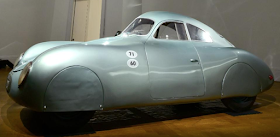Production cars carrying the Porsche brand name did not appear until 1948. However, hints of its design theme appeared in something called the Type 64, a three-car set of racing vehicles from 1939. One of those exists, and became the subject of an ill-fated auction in California this August. (Here is a link to Forbes magazine's web site, 19 August 2019: "Porsche Type 64 Auction Disaster Upends 2019 Monterey Car Week.") That aside, some purist Porsche fans do not consider the Type 64 a true Porsche because the brand did not exist in 1939.
The early Porsche production design was the model 356 produced 1948-1965 in "Pre-A," A, B and C variants. The currently active 911 Porsche line began replacing the 356s late in 1964.
The 64, Pre-A, and some later 356s are shown below along with an example of the 911 design. Unless otherwise noted, images are of cars listed for sale or are factory sourced.
The surviving Type 64, via Getty Images.
Now for three views of the 1948 Porsche 356 prototype No. 1. These are my photos taken October 2018 at the Volkswagen display center on Berlin's Friedrichstrasse.
Being a roadster, this prototype does not seem very Porsche-like except in the previous image showing the front.
Note the row of tiny slots for cooling the air-cooled motor.
A 356 Porsche built in Gmünd, Austria around 1950 before production was moved to Germany. The second prototype was similar to this. Although a little crude, the basic Porsche design elements are here.
Gmünd-built 356s about to head for the 1951 Le Mans race. Porsche won its class that year.
A German-built 356 from around 1952 at an Esso fueling station. These early models can be identified by their two-piece windshields.
A 1951 "Split-Window" 356, body by Reutter in a photo via RM Sotheby's.
The same car, rear quarter view showing the air intake on the hood.
Publicity photo from 1952.
Another "Pre-A" 356, this from 1953. The windshield is now one-piece, but the glass is bent at the center, following the two-piece derived sheet metal framing.
Publicity photo of a 1956 Porsche 356 A. This refined design with a curved windshield and larger rear-wheel cut-outs set the scene for remaining 356s.
Finally, a 1966 Porsche 912, the four-cylinder version of the new 911 design. My father owned one that looked like this. Note the carryover of the 356 theme of sloping hood, higher fender fronts with headlights, and the fastback rear.













No comments:
Post a Comment